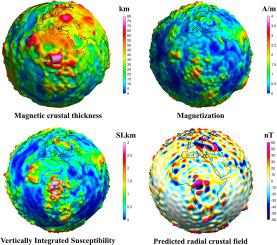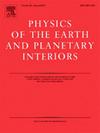利用统计方法估算磁化强度和磁性地壳厚度,揭示被地球主磁场掩盖的岩石圈磁场
IF 1.9
3区 地球科学
Q2 GEOCHEMISTRY & GEOPHYSICS
引用次数: 0
摘要
地球岩石圈磁场的详细地图为了解地壳的组成、动力学和地质历史提供了重要的见解。这个磁场可以用卫星和近地表磁场测量来模拟。然而,规模超过2500公里的结构被地核产生的主要磁信号所掩盖。地核和地壳磁场的叠加给地球动力学和地壳磁源研究带来了模糊性。以前解决这一问题的努力包括对地壳场长波分量的上下限的统计估计,以及基于地球物理先验(如地壳磁化和地震莫霍深度模型)的更确定的预测。然而,这些方法往往产生相互矛盾的结果。在本研究中,我们采用两步策略。第一步涉及世界数字磁异常网格(WDMAM2.2)的一系列区域球面谱分析,而不依赖于任何来自地震或磁化模型的先验信息。该方法应用于分布在地球表面均匀分布的6000个区域的5km × 5km WDMAM2.2网格,使我们能够估计6000个区域中每个区域中统计表征地壳磁化的三个关键参数的概率分布:磁化幅度、磁层厚度和幂律指数。由此得到的磁层厚度世界图与现有的莫霍深度模型有所不同,但从统计上看,在研究的长度尺度上,莫霍以下没有明显的磁源证据。第二步,利用区域磁化模型集合生成一组大尺度(1 ~ 50度)的岩石圈磁场球谐模型。这组数据使我们能够量化岩石圈磁场对地核磁场静态和时变分量的污染程度。我们发现这种污染在静态核心场的球谐度12和15之间是实质性的,并且从21度以后的长期变化。本文章由计算机程序翻译,如有差异,请以英文原文为准。

Unraveling the lithospheric magnetic field masked by the Earth’s main field by estimating the magnetization and magnetic crustal thickness using a statistical approach
Detailed mapping of Earth’s lithospheric magnetic field provides important insights into the composition, dynamics, and geological history of the crust. This field can be modeled using satellite and near-surface magnetic measurements. However, structures larger than approximately 2500 km in scale are obscured by the dominant magnetic signal generated by the Earth’s core. The superposition of core and crustal magnetic fields introduces ambiguities in both geodynamo and crustal magnetic source studies. Previous efforts to address this issue have included statistical estimates of upper and lower bounds on the long-wavelength components of the crustal field, as well as more deterministic predictions based on geophysical priors such as crustal magnetization and seismic Moho depth models. These approaches, however, have often produced contradictory results. In this study, we adopt a two-step strategy. The first step involves a series of regional spherical spectral analysis of the World Digital Magnetic Anomaly Grid (WDMAM2.2), without relying on any prior information from seismic or magnetization models. This approach, applied to the 5 km × 5 km WDMAM2.2 grid across 6000 regions uniformly distributed over the Earth’s surface, allows us to estimate the probability distributions of three key parameters statistically characterizing crustal magnetization in each of the 6000 regions: magnetization amplitude, magnetic layer thickness, and a power-law exponent. The resulting world map of magnetic layer thickness differs from existing Moho depth models but indicates that, statistically, there is no significant evidence of magnetic sources located below the Moho at the studied length scales. In the second step, the ensemble of regional magnetization models is used to generate a set of large-scale spherical harmonic models of the lithospheric magnetic field (degrees 1 to 50). This set allows us to quantify the extent to which the lithospheric field contaminates both the static and time-varying components of the core magnetic field. We find that this contamination is substantial between spherical harmonic degrees 12 and 15 for the static core field, and from degree 21 onward for the secular variation.
求助全文
通过发布文献求助,成功后即可免费获取论文全文。
去求助
来源期刊

Physics of the Earth and Planetary Interiors
地学天文-地球化学与地球物理
CiteScore
5.00
自引率
4.30%
发文量
78
审稿时长
18.5 weeks
期刊介绍:
Launched in 1968 to fill the need for an international journal in the field of planetary physics, geodesy and geophysics, Physics of the Earth and Planetary Interiors has now grown to become important reading matter for all geophysicists. It is the only journal to be entirely devoted to the physical and chemical processes of planetary interiors.
Original research papers, review articles, short communications and book reviews are all published on a regular basis; and from time to time special issues of the journal are devoted to the publication of the proceedings of symposia and congresses which the editors feel will be of particular interest to the reader.
 求助内容:
求助内容: 应助结果提醒方式:
应助结果提醒方式:


